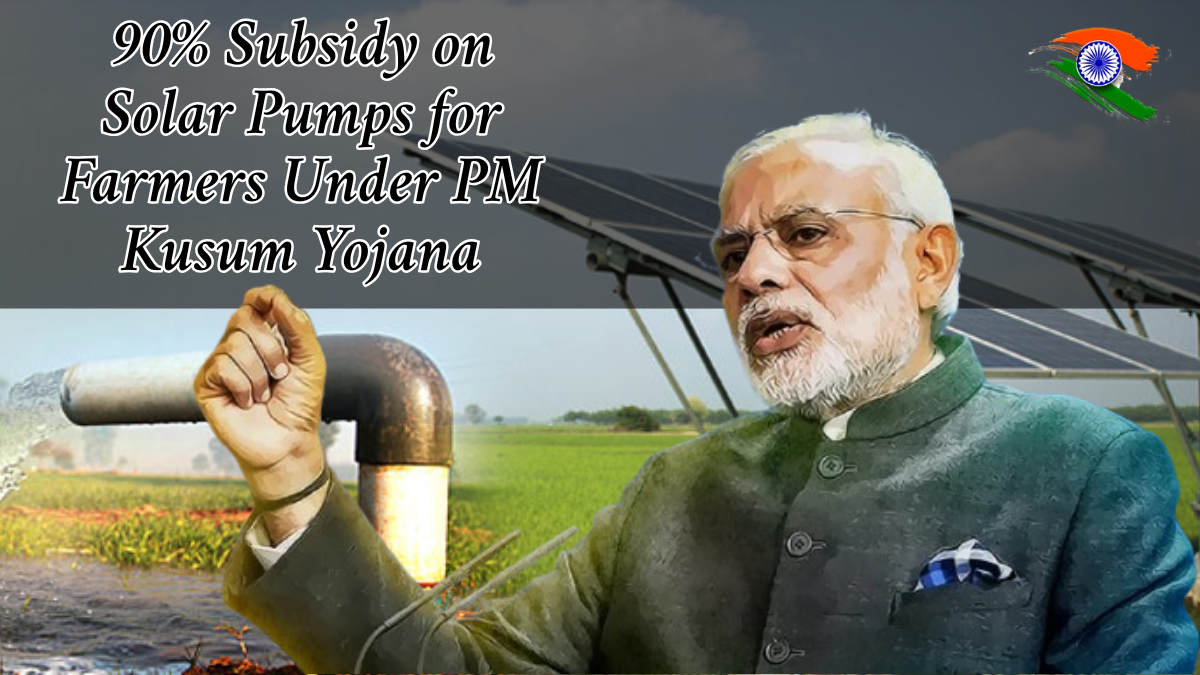The PM Kusum Scheme (Pradhan Mantri Kisan Urja Suraksha evam Utthaan Mahabhiyan) has emerged as a transformative initiative aimed at energizing India’s agricultural sector with solar power. Launched by the Ministry of New and Renewable Energy (MNRE), the scheme empowers farmers by offering up to 90% subsidy on solar pump installations. It promotes sustainable energy use, minimizes dependence on traditional power sources, and boosts farm productivity.

Summary Table: PM Kusum Scheme 2025
| Topic | Details |
|---|---|
| Scheme Name | PM Kusum Scheme |
| Year | 2025 |
| Subsidy Offered | Up to 90% on solar pumps |
| Target Beneficiaries | Registered farmers including small and marginal farmers |
| Application Mode | Online via official portal or through local agricultural offices |
| Implementation Partners | State Nodal Agencies (SNAs), DISCOMs, and Renewable Energy Service Companies (RESCOs) |
| Key Benefits | Reduced energy costs, improved irrigation reliability, sustainable agriculture practices |
| Maintenance Coverage | Included for the first five years as part of initial installation |
| Official Website | mnre.gov.in |
Objectives of the PM Kusum Scheme
- Enhance Energy Security for farmers
- Promote Use of Solar Energy in agriculture
- Reduce Dependence on diesel and grid electricity
- Boost Farmer Income through reduced input costs
- Support India’s Renewable Energy Targets
Key Benefits of the PM Kusum Scheme
- Significant Cost Savings: Farmers reduce electricity and fuel costs with solar energy.
- Reliable Irrigation: Solar pumps provide consistent and dependable water supply.
- Eco-Friendly Farming: Reduced carbon footprint aligns with climate goals.
- Accessible to All: Small and marginal farmers gain affordable access to solar tech.
- Government Support: Seamless application, installation, and maintenance support.
Components of the PM Kusum Scheme
The scheme comprises three main components:
- Component A: Installation of 10,000 MW of decentralized grid-connected renewable power plants.
- Component B: Installation of 20 lakh standalone solar-powered agriculture pumps.
- Component C: Solarization of existing grid-connected agriculture pumps.
For farmers, Component B is particularly beneficial, offering standalone solar pumps with up to 90% financial support.
Financial Breakdown: 90% Subsidy Explained
| Component | Subsidy Percentage | Eligibility | Process |
| Solar Pump Cost | 90% | Registered farmers | Apply via official portal/agri office |
| Installation | 90% | Small and marginal farmers | Included in subsidy |
| Maintenance | 90% (first 5 years) | All eligible beneficiaries | Covered in initial grant |
The remaining 10% is often manageable for farmers, sometimes supported by state-specific schemes or institutional credit.
Step-by-Step Guide to Apply for PM Kusum Scheme
- Check Eligibility
- Ensure you are a registered farmer.
- Confirm land ownership or long-term lease suitable for solar pump installation.
- Gather Required Documents
- Aadhaar card
- Land records
- Bank passbook
- Recent passport-sized photos
- Application Submission
- Visit the official PM Kusum portal.
- Choose your state and fill out the online application form.
- Submit the documents and await verification.
- Approval and Installation
- Receive official approval within 1 month of application.
- Coordinate with state nodal agencies for equipment installation.
- Maintenance and Support
- Ensure regular maintenance to maximize solar pump efficiency.
- Utilize free support for the first 5 years.
Implementation Timeline
| Step | Description | Estimated Duration |
| Eligibility Check | Confirm farmer status | Immediate |
| Application Submission | Fill and submit form | Within 2 weeks |
| Approval & Verification | Document review and inspection | Up to 1 month |
| Installation | Solar pump setup and handover | 2–4 weeks |
Eligibility Criteria
To participate in the PM Kusum Scheme, farmers must:
- Be Indian citizens with valid identification (Aadhaar)
- Be registered with their local agricultural department
- Own or lease land suitable for solar installations
- Preferably be small or marginal farmers (though all registered farmers can apply)
Real-Life Impact: Farmer Success Stories
Ramesh Kumar – Rajasthan
Installed a solar pump under PM Kusum and reduced diesel pump expenses, increasing crop yield.
Sunita Devi – Uttar Pradesh
A marginal farmer who used the subsidy to irrigate her fields independently, improving both income and crop quality.
Ajay Singh – Haryana
Utilized the scheme for solarizing his pump and now sells surplus power back to the grid.
Meena Yadav – Maharashtra
Turned barren land into productive farmland using solar irrigation.
These stories reflect the scheme’s capacity to empower rural livelihoods.
Broader Impact on Indian Agriculture
The PM Kusum Scheme isn’t just about solar pumps—it is part of a larger strategy to transform agriculture into a sustainable, efficient, and resilient sector.
- Lower Input Costs: Farmers save money on electricity and fuel.
- Increased Productivity: Reliable irrigation ensures better crop cycles.
- Climate Resilience: Renewable energy makes farming practices more climate-friendly.
- Rural Empowerment: Technological adoption boosts self-sufficiency.
Frequently Asked Questions (FAQs)
Q. Who is eligible for PM Kusum?
A. Registered Indian farmers with land ownership or lease
Q. What is the subsidy percentage?
A. Up to 90% on pump cost, installation, and maintenance
Q. Where can I apply?
A. On the MNRE official site or via local agriculture departments
Q. How long does approval take?
A. Typically 2–4 weeks post-application
Q. Is maintenance included?
A. Yes, for the first five years as part of the subsidy
Q. Can large farmers apply?
A. Yes, though priority is given to small and marginal farmers.
Conclusion: A Bright Future for Indian Farmers
The PM Kusum Scheme is not just a subsidy program—it is a vision for transforming rural India. By making solar energy accessible, the scheme is helping farmers become more independent, resilient, and profitable. The long-term advantages—from financial savings to environmental impact—make PM Kusum a cornerstone of India’s sustainable agricultural future.
To learn more or begin your application, visit the official MNRE website.
Click here to know more